Short-Term Load Probability Prediction Based on Integrated Feature Selection and GA-LSTM Quantile Regression
Abstract
Accurately forecasting electricity demand is crucial for maintaining the balance between supply and demand of electric energy in real-time, ensuring the reliability and cost-efficiency of power system operations. The integration of numerous active loads and distributed renewable energy sources into the grid has led to increased load variability, rendering the traditional point forecasting approach inadequate for meeting the evolving needs of the power system. Probabilistic forecasting, which predicts the complete probability distribution of loads and provides more extensive information on load uncertainty, has emerged as a key solution to address these challenges. The long short-term memory (LSTM) model, known for its strong performance in modeling long series, is commonly utilized in load forecasting. Therefore, this study focuses on short-term electric load probability forecasting for users in a specific park in Yantai. We propose a short-term load probability forecasting model based on integrated feature selection (IFS), genetic algorithm (GA) optimization of LSTM, and quantile regression (QR), referred to as the IFS-GA-QRLSTM model. Initially, the integrated feature selection method is employed to identify the most influential factors affecting electric load, optimizing the model’s input features and reducing data redundancy. To address the subjective nature of parameter selection in the LSTM model, we use a GA to optimize model parameters. The combination of optimized LSTM with QR enables direct generation of quantile load predictions, which are further used in kernel density estimation to construct the probability density distribution. We compare the proposed method with five basic models, QRLSTM, IFS-QRCNN, IFS-QRRNN, IFS-QRLSTM, and IFS-QRGRU, for point prediction, interval prediction, and probability prediction. Experimental results demonstrate that the proposed method in this paper exhibits better prediction performance, smaller prediction errors, and greater effectiveness compared to the aforementioned models.
1. Introduction
1.1. Background of the Study
The power system plays a crucial role in ensuring the normal functioning of the national economy and the daily lives of residents. To maintain the stability and reliability of the power system, accurate predictions of future power loads are essential to balance power generation with demand. In recent years, with an increasing focus on low-carbon environmental protection, new energy generation methods such as wind power, solar power, and hydroelectric power have emerged, among which the research on photovoltaic power generation hours prediction has achieved better results [1]. Although these sources are clean, their generation is susceptible to weather conditions and temperature, leading to complex and fluctuating load data. Consequently, predicting power loads in this new type of power system has become a key research area for scholars globally.
Before the power system became as complex as it is today, forecasting power loads only required providing a single point forecast to meet grid requirements [2]. However, with the introduction of new energy generation methods, the uncertainty in the power system has increased significantly. There is now a pressing need for a more precise method to assess this uncertainty. Probabilistic load forecasting emerges as a viable solution to this challenge [3]. This approach can offer a prediction interval [4] and the corresponding probability density function of the predicted load value at a specified confidence level. By doing so, it allows for a more accurate measurement of the uncertainty in load prediction and the distribution of predicted load values. This capability is crucial for power generation systems to make informed risk decisions and optimize power dispatching.
While probabilistic forecasting can assess the uncertainty of load forecasting, achieving high forecasting accuracy still relies on robust data support. The datasets used in the current literature are mostly public, which can allow scholars to reproduce their research results, but lack timeliness and are less convincing. At the same time, the existing research does not pay enough attention to the selection of important data features and tends to focus more on the research of new algorithms, overlooking the importance of data itself to the model. To address this gap, we propose a novel feature selection method to identify the variables most relevant to the target variables for input into the model. This paper not only focuses on point forecasting but also introduces interval forecasting and probabilistic forecasting of loads to offer more valuable insights for future load forecasting. For model selection, we leverage deep learning, a widely used approach, and further enhance prediction accuracy by optimizing model parameters through an optimization algorithm. This approach aims to effectively tackle the challenges in load forecasting.
1.2. Literature Reviews
The current research on power load forecasting can be broadly classified into four categories: ultra-short-term, short-term, medium-term, and long-term load forecasting. Ultra-short-term load forecasting involves predicting future loads at a granularity below the hourly level, typically used for real-time scheduling and control [5, 6]. Short-term load forecasting, on the other hand, focuses on forecasting loads from a few hours to a few days ahead, primarily for daily or weekly power generation planning [7, 8, 9, 10]. Medium-term and long-term load forecasting operate on monthly and yearly time scales, respectively, and are primarily utilized for power grid maintenance, reconstruction, and planning [11, 12]. However, due to the significant time gap between medium-term and long-term forecasting, the resulting prediction errors can be substantial, limiting practical applications [13, 14, 15]. Ultra-short-term forecasting tasks are usually managed by the power grid and dispatching departments due to their high real-time demands. As a result, the majority of research efforts in this area are concentrated on short-term power load prediction.
The single-point methods for short-term power load forecasting can be broadly classified into two types: traditional forecasting methods and modern forecasting methods. Traditional methods include time series forecasting [16], Kalman filter [17], exponential smoothing model [18], and multiple linear regression [19]. These methods model historical loads to predict future loads but are limited by their simple structure and linear relationship fitting capability, resulting in lower prediction accuracy, especially when dealing with nonlinear data. In contrast, modern methods such as machine learning [20] and deep learning [21] have gained popularity in the big data era. These methods are adept at handling fluctuating data and improving nonlinear fitting capabilities, leading to higher prediction accuracy in power forecasting. In this context, Aslam et al. [22] compared the performance of different artificial neural networks and machine learning methods in forecasting electricity generation in residential and commercial sectors and found that the efficiency of these forecasting methods highly depends on historical data, which fully demonstrates that data preprocessing is a key factor affecting model performance. Giacomazzi et al. [23] explored the ability of the transformer architecture in short-term hourly load forecasting for the present and different power grid levels. The results showed that its forecasting performance is far inferior to the long short-term memory (LSTM) model. However, when the transformer applied at the substation level with a subsequent aggregation to the upper grid-level, it appears to offer remarkable improvements over the LSTM approach. To better assist researchers in making meaningful model choices, Hopf et al. [24] reviewed 421 forecasting models from 59 past studies and found that LSTM and the combination of neural networks with other methods can improve the accuracy of forecasting results.
In view of the current new power system, domestic and foreign scholars have conducted research on how to measure the uncertainty of power load. Haben et al. [25] reviewed some research on low-voltage forecasting, and they pointed out that the challenges faced by current smart meter forecasting are similar to those of low-voltage forecasting, both of which have instability and require probabilistic forecasting to estimate their associated uncertainties. In the 2014 Global Energy Forecasting Competition, Xie and Hong [26] proposed a probabilistic load forecasting solution for measuring load uncertainty, and since then, probabilistic forecasting of loads has become a hot topic in academic research. Xu et al. [27] proposed a probabilistic load prediction method for individual buildings and established an ANN model for probabilistic normal load prediction and a statistical model for probabilistic anomalous peak prediction. Wang et al. [28] used the constrained quantile regression averaging method (CQRA) for the integration of multiple single probabilistic prediction models and demonstrated that the predictive performance of the integrated prediction was significantly improved compared to the single prediction. Dengwu et al. [29] proposed a power load interval prediction method combining deep learning and quantile, which can output the prediction results of multiple quantiles and then obtain the load prediction interval at a given significance level. Literature [30] proposed a user-level short-term probabilistic load forecasting method for night economy. This method first used LightGBM for point forecasting, took the output obtained from point forecasting as the input of probability forecasting, then used kernel density estimation method to estimate the probability density and forecast interval of future short-term load of different night economy users, and conducted experiments on multiple types of night economy users. All of them showed good effect. Literature [31] proposed a probabilistic load prediction method for individual users by replacing the mean square error with the pinball loss as the loss function of the LSTM for model training, thus extending the traditional LSTM-based point prediction into a quantile form of probabilistic prediction. As feature variable selection is also one of the key factors affecting model training, Li Jinyang proposed to combine copula method and XGBoost algorithm, so as to select the most relevant influencing factors of power load. Then, this variable screening method was put into the three quantile prediction models of QRLSTM, QRF, and QRGB, and the experimental results showed that the prediction accuracy of the proposed models was improved [32]. Wei et al. [33] proposed a multifeature short-term power load forecasting method. First, the original load data were decomposed into N modes and one residual through variational mode decomposition VMD, and the N modal components were predicted by LSTM in a single variable. Then, the residual and weather and date features are combined together to make LSTM multifeature prediction. Finally, the above prediction results are taken as the whole feature to make multifeature load prediction through LightGBM. Experimental results show that the prediction error of this method is lower than that of traditional machine learning algorithms. In the literature [34], in order to alleviate the possible overfitting as well as high complexity problems of QLSTM models, it was simplified using nonconvex MCP regularization, and finally, the model parameters in LSTM and MCP were optimized by whale algorithm, which significantly improved the prediction accuracy of the model.
Based on the current research status, we introduce a novel IFS-GA-QRLSTM hybrid model for short-term load probabilistic forecasting. This model initially conducts feature screening by incorporating a feature selection algorithm to eliminate unnecessary features. Subsequently, the hyperparameters of the LSTM model are fine-tuned using a genetic algorithm and integrated with quantile regression to predict values at various quantile points. The results include point prediction, interval prediction, and probabilistic prediction of loads, demonstrating the enhanced performance of the proposed method in this study.
1.3. Contributions
- (1)
The dataset used in this study is from the real-time load data of users in a certain park in Yantai, which includes information on weather conditions, temperature, and wind direction. For the textual data, we have split and encoded it. At the same time, in order to comprehensively examine the feature factors that affect the load data, we have also extracted seven time-related factors that have a significant impact on it, ensuring the comprehensiveness of the features.
- (2)
We propose a new integrated feature selection method, which is not limited to the feature selection of a single model but integrates RF, XGBoost, and LightGBM models and combines the feature importance scores obtained by their respective training through a weighted method, so as to obtain the final feature importance scores. Finally, it filters the features based on a predefined score threshold to select the most important features.
- (3)
We propose to optimize the hyperparameters of LSTM by genetic algorithm, which includes the number of LSTM layers, dense layers, hidden layer neurons, and dense layer neurons, in order to further improve the prediction accuracy of the model.
- (4)
In this study, an LSTM model optimized using genetic algorithms is integrated with a nonlinear quantile regression model to provide probabilistic load data predictions for a specific park in Yantai. The analysis of the prediction results is conducted based on three main aspects: point prediction, interval prediction, and probability prediction.
2. Methodologies
2.1. Integrated Feature Selection
- (1)
First of all, the data are preprocessed, including data cleaning and normalization operations.
- (2)
The preprocessed data are divided into the training set and the test set according to the ratio of 8 : 2.
- (3)
RF, XGBoost, and LightGBM models are established, respectively, and the above three models are taken as the base learners of the overall method. Then the segmented data are input into the above three models for training and testing.
- (4)
Set the weighting coefficient wi(i = 1, 2, 3) of each model, and according to the advanced degree of the above algorithms, order them from strong to weak as LightGBM, XGBoost, and RF, and set their coefficients as 0.5, 0.4, and 0.1, respectively, that is, w1 = 0.5, w2 = 0.4, w2 = 0.4.
- (5)
The feature importance scores of each feature obtained by the three base learners are denoted as , where j = (1, 2, …, n) represents the j feature and n represents the total number of features in the dataset.
- (6)
Calculate the final feature importance score :
- (7)
The importance scores of the above features are sorted in descending order, and the required number of features is selected according to the actual situation. The design process of the algorithm is shown in Figure 1.
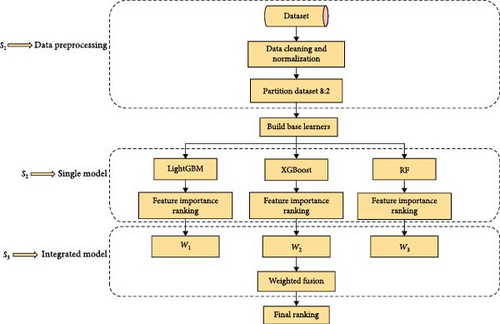
2.2. GA
The implementation steps of genetic algorithm can be divided into five stages: chromosome coding, initial population, fitness evaluation, genetic operator, and termination condition judgment. The chromosome coding stage can be divided into two parts, namely, encoding and decoding. Encoding can be understood as a transformation method, that is, to convert the feasible solution of a practical problem into a representation suitable for genetic algorithms. Similarly, decoding is also a conversion method, that is, the conversion of genetic algorithm chromosomes to problem solutions. The operation of encoding and decoding is to facilitate the subsequent genetic algorithm operation. The initial population means that before establishing the algorithm model, the solution population in the search space needs to be defined in advance, and a series of parameters are set, including the maximum evolutionary algebra T, population size M, crossover probability Pc (generally set in the range of 0.4–0.99), and mutation probability Pm (generally set in the range of 0.001–0.1). Randomly generate M individuals as the initial group P0. Next, it is crucial to establish the fitness function in the genetic algorithm, which serves as a metric for evaluating the relative quality of individuals within the population. In the approach outlined in this paper, the reciprocal of the mean square error (MSE) of the prediction model is utilized as the fitness value. After setting the fitness function, it is necessary to calculate the genetic operator, that is, select, cross, and mutation operations. Population P(t) underwent the above three genetic manipulations; the next generation of population P(t + 1) is obtained. The final step involves defining termination conditions to achieve the optimal solution for the problem. The algorithm terminates when the fitness function reaches a predetermined optimal value or when the maximum number of iterations is reached. The entire operational process of the algorithm is illustrated in Figure 2.
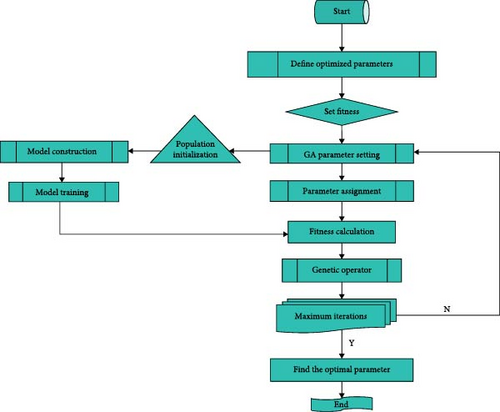
2.3. LSTM
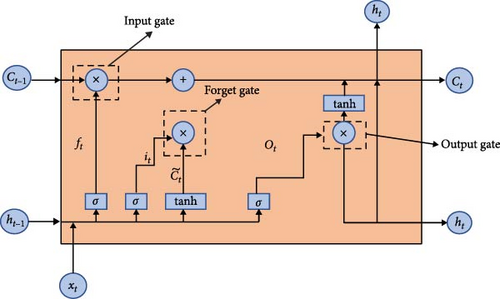
2.4. Probabilistic Prediction Model
Through quantile regression, we can obtain the predicted values of different quantiles corresponding to a certain time, but these predicted values are discrete points. To derive the probability density function of various predicted points, we must input the aforementioned series of quantile values into the kernel density estimation. This process will allow us to calculate the probability density function of the forecasted load. The specific steps are as follows:
By using the above expression, the probability density function at any given point can be determined, enabling a better observation of the distribution of load data.
3. Data Preprocessing
3.1. Dataset Introduction
The dataset used in this paper is derived from the electricity load data of a park user in Yantai from January 1, 2018, 0:00:00, to August 31, 2021, 23:45:00, with a total of 128,157 pieces of data. It is collected every 15 min and contains five columns of meteorological characteristic data and one column of load data, including electricity load, weather conditions, maximum temperature, minimum temperature, daytime wind direction, and night wind direction. Among them, the weather condition, daytime wind direction, and night wind direction are text-based data. In order to explore the time correlation of the dataset selected in this paper, Figures 4, 5, 6, and 7, respectively, show the time series of load data in 1 day, 1 week, different months, and different years.

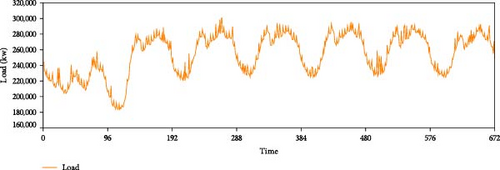
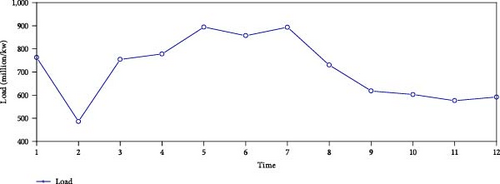
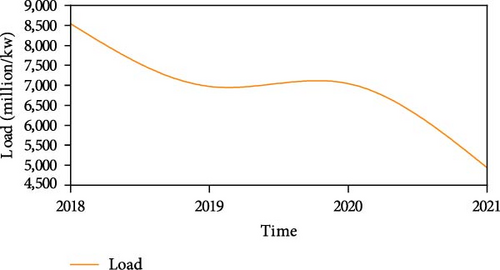
The figure clearly shows distinct peak and trough values in different periods of the day, suggesting that the number of days is also a factor impacting the load. The data show an obvious periodicity within a week, and its electricity consumption pattern is also very different in different months, and it also shows an obvious trend in different years. Therefore, based on the above analysis, we will extract time-related factors to ensure the integrity of load influencing factors.
3.2. Missing and Outlier Processing and Data Standardization
The variables in the equation have the following meanings: Qnorm is the normalized value, Q is the value that needs to be normalized, and Qmax and Qmin are the maximum and minimum values before normalization, respectively.
3.3. Time-Dependent Feature Extraction and Coding
Based on the analysis of the time series diagram above depicting the power load of park users, it is evident that the power load is significantly influenced by time factors including days, week, months, and years. To comprehensively investigate the factors influencing load characteristics, additional meteorological factors need to be incorporated into the analysis. Then, seven time features related to the load, namely, year, month, day, weekday, weekend, week, and holiday, are extracted, and the extracted time-related features are combined with the above meteorological features and load data, and finally, compose a complete dataset. Then, for the text data in the dataset, it needs to be converted into numerical data for subsequent operations. The “Weather Conditions” feature column in the dataset looks like this: ”Multi-cloud/multi-cloud”, so the practice in this paper is to divide it into two columns according to “/”, start_weather before “/”, end_weather after “/”, and then encode the label. The encoding range is 0–16. Then, label coding is also carried out for the two text-type feature columns of daytime wind direction and night wind direction, and the encoding range is 0–27. Finally, a dataset containing one column of load data and 13 columns of feature data is obtained. The description and coding of characteristic variables in the dataset are shown in Tables 1 and 2.
| Input type | Variable name | Variable description |
|---|---|---|
| Target variable | Total active power | Unit (kw) |
| Characteristic variable | Maximum temperature | Unit (°C) |
| Minimum temperature | Unit (°C) | |
| Daytime wind direction | Such as no sustained wind direction <3 | |
| Night wind direction | Such as north wind 3–4 | |
| Start_weather | Such as cloudy/cloudy | |
| End_weather | Such as sunny/sunny | |
| Year | 2018–2021 | |
| Month | 1–12 | |
| Day | 1–31 | |
| Weekday | 1–7 | |
| Week | 1–5 | |
| Weekend | 0–1 | |
| Holiday | 0–1 | |
| Textual feature | Encoding |
|---|---|
| Daytime wind direction | 0–27 |
| Night wind direction | 0–27 |
| Start_weather | 0–16 |
| End_weather | 0–16 |
3.4. Integrated Feature Selection
Since the above preprocessed data contain a total of one column of load data and 13 columns of feature data, totaling 14 columns, the data dimension is large, which may affect the prediction accuracy of the subsequent model, so it is necessary to carry out feature screening of the above dataset and to select the features with a greater impact on the power load as inputs to the final model. This paper innovatively proposes to screen the above features by integrating the feature selection algorithm, which mainly uses RF, XGBoost, and LightGBM algorithms as the base learners, trains them separately to obtain the feature importance scores, and then weights and fuses the feature importance scores obtained from the above three models to finally obtain the final feature importance scores. This is achieved by initially splitting the dataset into a training set, which comprises 70% of the data, and a test set, which comprises 30% of the data, and then normalizing the data and inputting it into the integrated feature selection model for training, and finally obtaining the feature importance rankings of all the features, the results of which are shown in Figure 8.
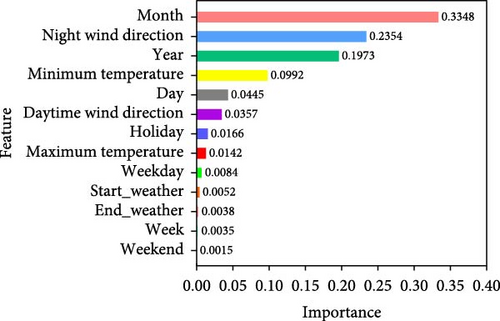
Based on the actual situation, we set the threshold of feature importance score to 0.005 and delete the features with scores lower than 0.005, that is, end_weather, Week, and Weekend. Retain 10 characteristic variables: Month, Night wind direction, Year, Minimum temperature, Day, Daytime wind direction, Holiday, Maximum temperature, Weekday, and Start_weather.
4. Evaluation Metrics
4.1. Point Prediction Evaluation Metrics
4.2. Interval Prediction Evaluation Metrics
4.3. Probability Prediction Evaluation Metrics
5. IFS-GA-QRLSTM
5.1. Introduction
This paper proposes a new hybrid probabilistic prediction model, IFS-GA-QRLSTM, to address the lack of research in load probability forecasting and variable feature screening methods. The model begins by employing an integrated feature selection algorithm to identify the 10 most relevant features for load data. The data are then divided into training and test sets, with 80% used for training and 20% for testing. To optimize the model parameters automatically, a genetic algorithm is utilized to determine the number of LSTM layers, dense layers, hidden layer neurons, and dense layer neurons. The model integrates LSTM with quantile regression to generate point, interval, and probability predictions. The results are comprehensively analyzed to draw conclusions. The structural design of the model is illustrated in Figure 9.
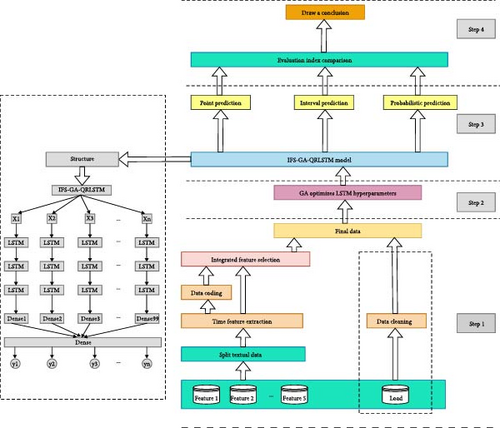
5.2. Experimental Setup
- (1)
Hyperparameter settings for IFS-GA-QRLSTM and baseline models
In the implementation of deep learning tasks, the selection of parameters plays a crucial role in determining the training accuracy of the model. Table 3 provides a detailed comparison of the parameter configurations between the IFE-GA-QRLSTM model and the baseline models.
| Algorithm | Hyperparameter | Value |
|---|---|---|
| IFS-GA-QRLSTM and baseline models | Time_step | 96 |
| Batch size | 32 | |
| Number of LSTM layers | 2 | |
| Number of dense layers | 1 | |
| LSTM units | 30 | |
| Dense units | 64 | |
| Optimizer | Adam | |
| Learning rate | 0.005 | |
| Epochs | 150 | |
| Loss function | Pinball loss | |
| Activation function | relu, tanh | |
| Dropout | 0.1 |
- (2)
Hyperparameter setting of GA
The accuracy of a genetic algorithm is primarily determined by parameters such as DNA_size, DNA_size_max, POP_size, Cross_rate, Mutation_rate, and N_generations. When applying a genetic algorithm to optimize LSTM hyperparameters, it is important to consider that increasing the number of LSTM layers can lead to higher computational costs for the prediction model. Some studies have utilized a two-layer LSTM network structure to improve the predictive performance of time series data. However, it has been noted in literature that exceeding three layers in an LSTM network may result in significant gradient vanishing issues between layers. Therefore, the design of deep LSTM network structures typically restricts the number of LSTM layers to 1–3, with the number of neurons in the hidden layer falling within the (32, 256) range. The hyperparameters of the genetic algorithm are outlined in Table 4.
| Algorithm | Hyperparameter | Value |
|---|---|---|
| GA | DNA_size | 2 |
| DNA_size_max | 8 | |
| POP_size | 20 | |
| Cross_rate | 0.5 | |
| Mutation_rate | 0.01 | |
| N_generations | 20 |
- (3)
The parameter results after GA optimization
In this paper, GA will optimize the number of LSTM layers, dense layers, hidden layer neurons, and dense layer neurons. The optimized results are displayed in Table 5.
| Optimized hyperparameter | Before | After |
|---|---|---|
| Number of LSTM layers | 2 | 3 |
| LSTM units | 30, 30 | 82, 175, 67 |
| Number of dense layers | 1 | 1 |
| Dense units | 64 | 94 |
The above optimization results were obtained by finding out the gene corresponding to the chromosome with the greatest fitness, where the maximum fitness was 3,489.7931. It can be observed from the table that the number of layers in the optimized LSTM becomes three layers, and the dense layer is still one layer, but the number of hidden neurons has significant changes. Next, we will adjust the parameters of the IFE-QRLSTM model based on the above optimization results and then carry out the subsequent case analysis.
5.3. Experimental Environment
The experimental setup for this study involved using PyCharm interpreter, Python 3.8, and TensorFlow 2.6 GPU versions to develop a short-term power load probability prediction model for campus users. The model was built using the TensorFlow and Keras frameworks.
5.4. Experimental Analysis and Evaluation
5.4.1. Point Prediction
For a single point prediction, we use the previous day’s data, namely, 96 data points, to predict the load data of the next moment, and take the output of the model with a quantile of 0.5 as the output of the actual point prediction. Figure 10 shows the forecast results of the first 3 days of the IFS-GA-QRLSTM model.
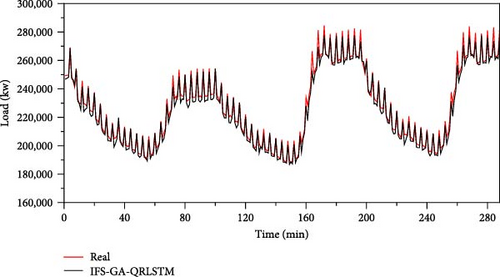
In order to further validate the predictive performance of the IFS-GA-QRLSTM model, we selected five basic models, namely, QRLSTM, IFS-QRCNN, IFS-QRRNN, IFS-QRGRU, and IFS-QRLSTM, and compared them with IFS-GA-QRLSTM. QRLSTM represents the model that combines LSTM with quantile regression. IFS-QRLSTM represents the model that first performs integrated feature selection on the data and then combines LSTM with quantile regression. IFE-GA-QRLSTM represents the model that first performs integrated feature selection on the data, then optimizes the hyperparameters of LSTM using a genetic algorithm, and finally combines it with quantile regression to form the final model. The other comparison models are similar to the ones mentioned above. The prediction results of different models are shown in Figure 11.
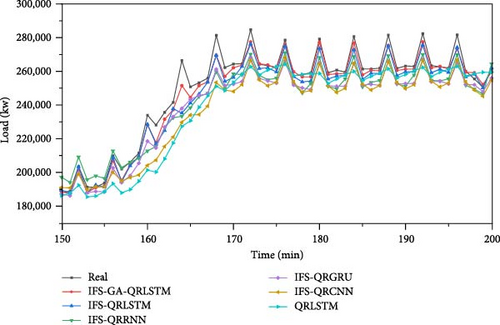
The figure illustrates that the prediction results of the IFS-GA-QRLSTM model are more closely aligned with the true value curve when compared to the other models. In order to show the prediction errors of different models more clearly, we compare the above models in detail through the four-point prediction evaluation indexes of MAE, RMSE, MAPE, and R2, and the results are shown in Table 6.
| Index | QRLSTM | IFS-QRCNN | IFS-QRRNN | IFS-QRGRU | IFS-QRLSTM | IFS-GA-QRLSTM |
|---|---|---|---|---|---|---|
| MAE | 7,217.7585 | 6,739.1801 | 5,639.9237 | 4,889.7566 | 2,752.7269 | 2,155.0767 |
| RMSE | 10,360.6550 | 9,365.1681 | 8,030.5217 | 7,052.9051 | 5,767.0652 | 5,070.7624 |
| MAPE | 3.7857 | 3.4566 | 3.1002 | 2.4861 | 1.6245 | 1.3408 |
| R2 | 0.8964 | 0.9153 | 0.9377 | 0.9520 | 0.9679 | 0.9752 |
It can be clearly seen from the table that the prediction effect of IFS-GA-QRLSTM model is the best, followed by IFS-QRLSTM, IFS-QRGRU, IFS-QRRNN, IFS-QRCNN, and QRLSTM. The R2 of IFS-GA-QRLSTM model reached 0.9752, which was increased by 0.75%, 2.44%, 4.00%, 6.54%, and 8.79% compared with IFS-QRLSTM, IFS-QRGRU, IFS-QRRNN, IFS-QRCNN, and QRLSTM models, respectively. The MAE is 2155.0767, which is decreased by 21.71%, 55.93%, 61.79%, 68.02%, and 70.14% compared with the above five models. The RMSE was 5070.7624, which was decreased by 12.07%, 28.10%, 36.86%, 45.86%, and 51.06% compared with the above five models. Its MAPE value was 1.3408, which was reduced by 17.46%, 46.07%, 56.75%, 61.21%, and 64.58% compared with the above five models. The superior point prediction results of the IFS-GA-QRLSTM model demonstrate the effectiveness and efficiency of the integrated feature selection algorithm proposed in this paper.
5.4.2. Interval Prediction
For interval prediction, we will continue to use the dataset mentioned above to predict the data for the next time interval based on the data from the previous day. However, different from point prediction, interval prediction can give the predicted value under different quantile at the next moment. In this paper, the quantile value interval is set as (0.01, 0.99), with a quantile interval of 0.01. Therefore, there are a total of 99 quantiles. That is, the value of 99 quantiles at the next moment is predicted, and the 0.05 quantile is used as the lower bound of the prediction interval, the 0.95 quantile is used as the upper bound of the prediction interval, and the prediction interval of 90% of the predicted value is given. The interval prediction results of IFS-GA-QRLSTM model and 90% of the above five comparison models are shown in Figure 12.
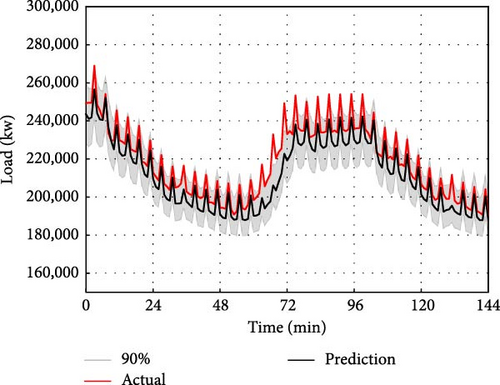
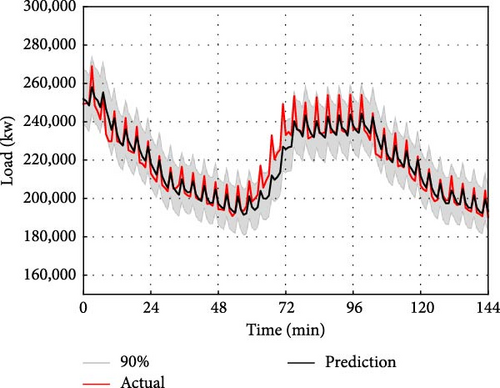
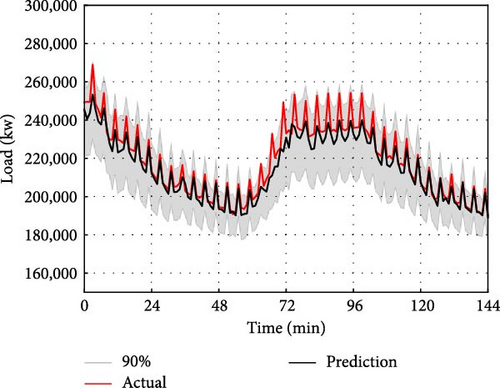
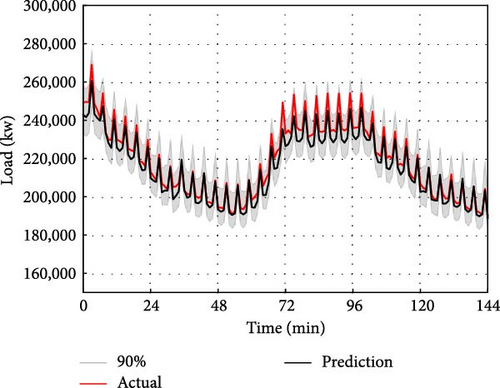
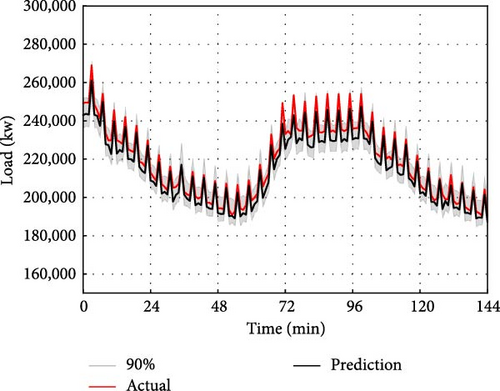
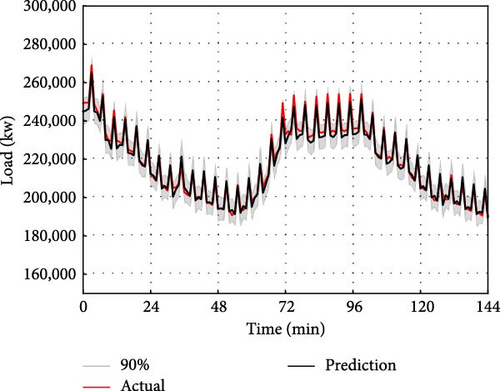
The interval prediction effect of the IFS-GA-QRLSTM model is superior to that of other basic models as depicted in the figure. This is evident from the narrow interval bandwidth and the prediction interval which almost fully encompasses the actual value. To provide a clearer description of the prediction performance of the IFS-GA-QRLSTM model, this paper utilizes the evaluation indicators of PICP and PINAW for interval prediction analysis. The evaluation index pairs for the aforementioned model are presented in Table 7.
| Index | QRLSTM | IFS-QRCNN | IFS-QRRNN | IFS-QRGRU | IFS-QRLSTM | IFS-GA-QRLSTM |
|---|---|---|---|---|---|---|
| PICP | 0.8575 | 0.9319 | 0.9442 | 0.9515 | 0.9636 | 0.9947 |
| PINAW | 0.0833 | 0.1101 | 0.0962 | 0.0767 | 0.0612 | 0.0439 |
The table clearly shows that the IFS-GA-QRLSTM model outperforms others in terms of the two evaluation indicators mentioned, followed by IFS-QRLSTM, IFS-QRGRU, IFS-QRRNN, IFS-QRCNN, and QRLSTM. The PICP of the IFS-GA-QRLSTM model reached 0.9947, and the coverage rate of the prediction interval reached the highest, which was increased by 3.23%, 4.54%, 5.35%, 6.74%, and 16% compared with the above five models. PINAW is 0.0439, which is the narrowest interval width compared with the other five basic models, and decreased by 28.27%, 42.76%, 54.37%, 60.13%, and 47.30% compared with the above four models, respectively. Therefore, it can be shown that the IFS-GA-QRLSTM model still performs best in interval prediction.
5.4.3. Probabilistic Prediction
For probabilistic prediction, we still use the above dataset to predict the next moment through the load data of the previous day. Unlike point and interval prediction, probabilistic prediction can be done by taking the 99 quantile values of the predicted point and inputting them into the kernel density estimation as a set of random variables, which gives the probability density function of that predicted point. Figure 13 illustrates the probabilistic prediction results at the 81st point for the six models described above.
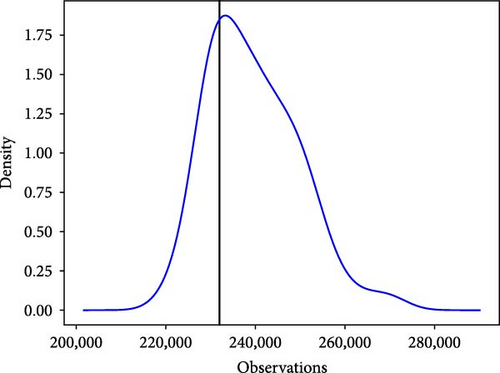
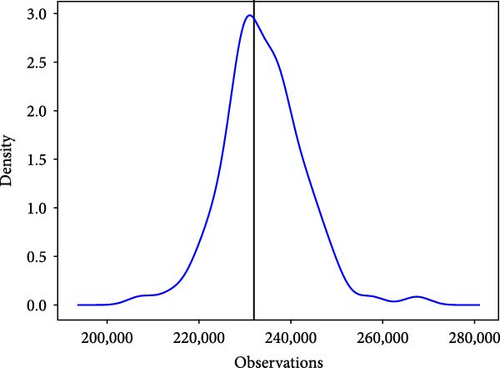
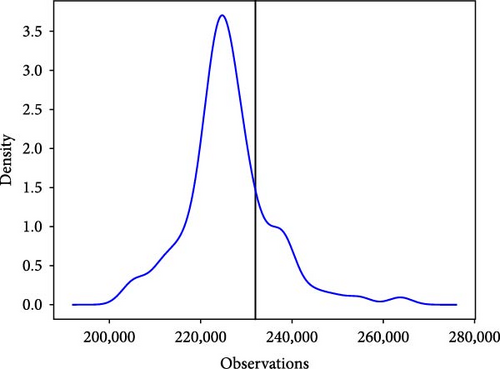
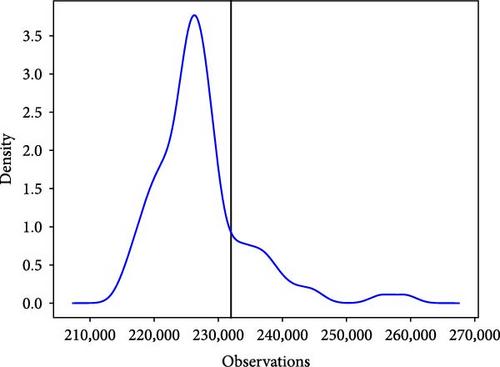
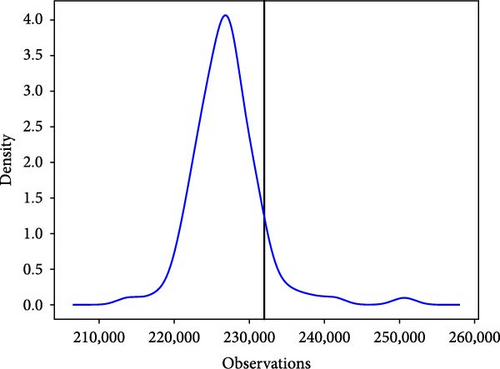
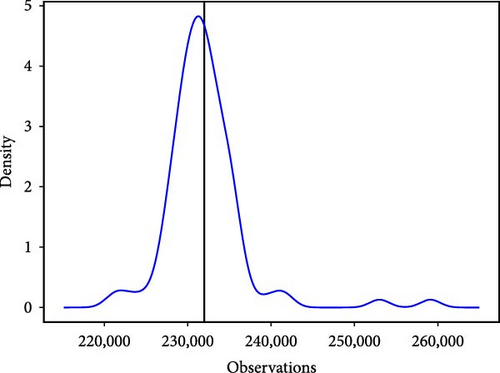
The black vertical line in the figure above represents the true value of the 81st point, and the red curve represents the probability density function of the point. It can be observed from the probability density function diagram that the true values of the six models fall within the curve and are relatively close to its highest point. Among the six basic models, the IFS-GA-QRLSTM model stands out as its peak value aligns closely with the actual load value, exhibiting the highest density at this point and the most stable curve. This further indicates that the IFS-GA-QRLSTM model performs better in probability prediction compared to the other five models.
Similarly, to better compare the predictive performance of different models, we use APL and CRPS to further evaluate the aforementioned models. Figure 14 presents the comparison results of evaluation indexes of the five models.
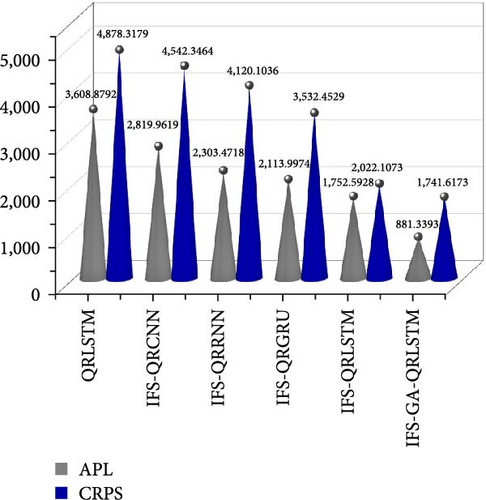
The IFS-GA-QRLSTM model exhibits the smallest APL and CRPS values among the models shown in the figure, indicating that its predicted values are closest to the actual values. This suggests that the model has the smallest prediction error and the best predictive performance. It is followed by IFS-QRLSTM, IFS-QRGRU, IFS-QRRNN, IFS-QRCNN, and QRLSTM. The APL value of IFS-GA-QRLSTM model was 881.3393, which decreased by 49.71%, 58.31%, 61.74%, 68.75%, and 75.58%, respectively, compared with the above five models. The CRPS value was 1741.6173, which was decreased by 13.87%, 50.70%, 57.73%, 61.66%, and 64.30%, respectively, compared with the above five models. Therefore, it has been demonstrated that the IFS-GA-QRLSTM model has the best predictive performance, significantly reducing prediction errors compared to other models.
6. Conclusions
Regional short-term load probability prediction plays a crucial role in power dispatching within power systems and energy management. In this study, a novel hybrid model, IFS-GA-QRLSTM, is proposed and evaluated in terms of point prediction, interval prediction, and probability prediction. It is compared against five basic models: IFS-QRLSTM, IFS-QRGRU, IFS-QRRNN, IFS-QRCNN, and QRLSTM. Results indicate that the IFS-GA-QRLSTM model outperforms the others, demonstrating the smallest prediction error and the best forecasting effect, affirming the superiority of the proposed approach. As technology advances, new methods will continue to enhance power load forecasting accuracy to meet diverse needs. While this study shows promising results, it still lacks in certain aspects. Future research should explore the application of the proposed method in medium- and long-term load probability prediction, investigate additional combined forecasting models, conduct comprehensive comparative tests, and identify the optimal model to enhance the stability of load probability prediction.
Conflicts of Interest
The authors have no conflicts of interest to declare.
Acknowledgments
This work has been supported by the Shangdong Province Social Science Planning and Research Project (no. 23CSDJ12).
Open Research
Data Availability
The power load data used to support the findings of this study were supplied by a regional power grid company in Yantai under license and so cannot be made freely available. Requests for access to these data should be made to Xigao Shao, [email protected].




